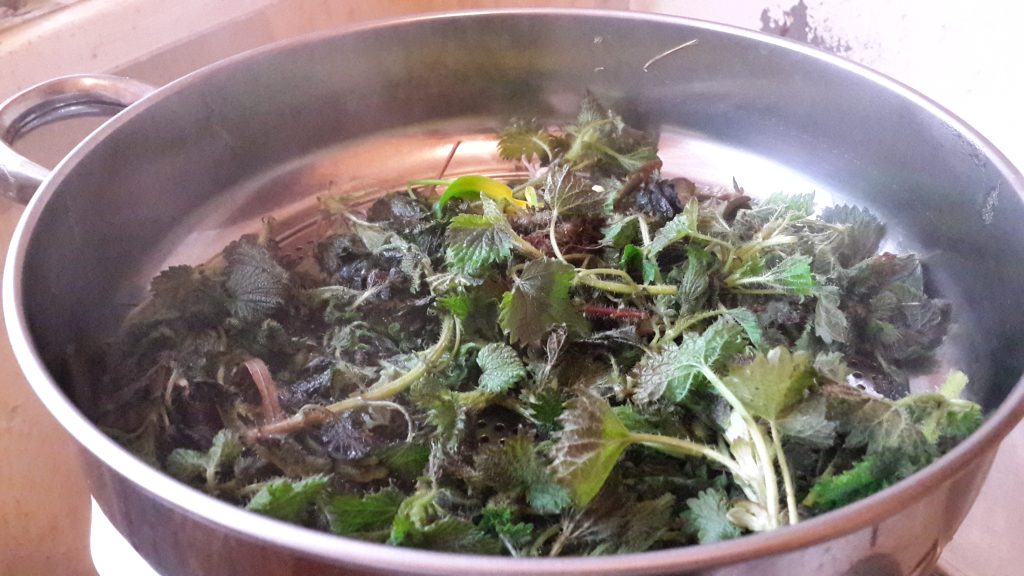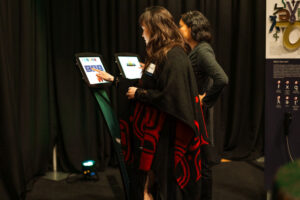During a pandemic, Indigenous communities tend to be among the most vulnerable, given their often-limited access to water, food supplies, adequate healthcare, and other factors. In this special “Pandemic Perspectives” series of our Dispatches, we’re sharing stories from around the world to shed some light on the obstacles Indigenous Peoples face in light of COVID-19 lockdowns—along with the ingenuity and unity with which they’re facing them. This post is by Ceren Kazancı, a PhD student in ecology at Ilia State University. She’s a member of the Laz ethnic group, which lives in the Western Lesser Caucasus in the Georgia-Turkey border region.

Ceren Kazancı interviewing a Laz elder about her memories as part of a cultural research project. Photo: Duygu Bostancı, 2019
Dear friends,
I’m a little away from my Laz community—my People, in Arhavi, Turkey. Fortunately, there is only a state border between us. I am talking to all my relatives in the cities and villages by phone. There are no known cases of COVID-19 in our villages yet, but it has started in the nearby towns and villages.
The situation creates concerns among the Laz people. My 96-year-old grandfather has not yet fully understood the reality of COVID-19. However, my 60-year-old beekeeper uncle worries about his subsistence because the Turkish government is taking new measures day by day that cause uncertainty among people whose livelihood predominantly depends on nature. Sudden decisions taken by the government directly and indirectly impact their livelihood. For example, the decision of opening the fertile pastures to monoculture agriculture would restrict people’s natural resources. Moreover, the government is taking advantage of communities “staying at home”; the situation accelerates quick decisions related to destructive investments (like large mining, dam, and road projects) without input from community members. Various quarantine restrictions silence community members’ voices as well.

Workers spraying Istanbul streets with disinfectant during the COVID-19 pandemic. Photo: IBB Istanbul
Last week, a mayor and his wife in Southwestern Turkey were shot after the politician called for a halt of destructive construction in Lake Salda—a protected area known for its white beaches and distinct color. Fortunately, the couple are recovering. In addition, nature defenders protesting against a gold mining project in Kaz Dağları-Ida Mountain (Northwest Turkey) were served a summons to stop the protest and to leave their camping site, where they have been living and guarding the land for a year. We are afraid that people will wake up and see these changes once they step out of their homes after the pandemic is over. What is worse is that we do not know when this will happen. These unpredictable decisions might cause more harm than good in the long run. What’s more, for cities and towns, the excessive and frequent uses of disinfectant agents in street cleaning and body cleaning might have direct/indirect adverse effects on our health as well as water and natural environments.
Although I am currently living in an isolated town away from a big city out of Turkey, similar difficulties are valid for me too. I respect social distancing rules. I do not quit my relations with my neighbors; most of them are elders. I keep an eye on them and drink coffee and tea in the gardens. I and my friend Soner frequently drink herbal teas and go for plant gatherings in the forest. We eat at least one wild plant dish every day. We feel better. I also offer a lecture on the identification of trees for ecology students via online meetings. It is not easy, compared to face-to-face meetings and feelings. I wish these days would pass very soon.

Nettles cooked with steam, prepared by Ceren and her friend Soner.
Let me talk about the hopeful side of this new situation. At the beginning of COVID-19 restrictions, I felt a bit disappointed about my future ethnobiology research. But I am trying to find alternative methods to connect with my elders. I had been developing my mother tongue for a few years by visiting and living with my community frequently. Now, I am trying to find new ways to continue my communication. For example, I’m doing my interviews via phone by sending structured detailed questions related to my studies. I realized that this kind of communication seems to be good enough, even, to bond our cultural ties. I see an increase in the network among different generations in my community living in separate parts of Turkey.

Ceren’s aunt, staying at home in her village during the pandemic. Photo: Ali Kazancı, 2020
In addition, I’d like to share some pictures from my close relatives in our village. Some of my relatives and cousins who had started working recently in the big cities are now coming back to our homeland. They seem to have gained new appreciation for the importance and value of lifestyle in their mother-earth. They painfully experienced the difficulties of living in big cities again.

Warming the hearth with traditional Turkish bread, made by Ceren’s cousin Ali. Photo: Ali Kazancı, 2020
For example, one of my cousins came back to our village and spent his two weeks quarantine there alone. Since he is very used to village life, he quickly adapted and is doing his best for survival. He started to learn how to cook traditional Laz dishes from his family. I feel this will allow him to re-establish his ties to our land and culture. He even started to promote his village times by making a hashtag: “♯stayatvillage.”
Another emotive event developed a few days ago. I asked my father (66) for some drawings on the cultivation and harvesting processes of one of our community’s ancient cereal crops—foxtail millet (“kurumi”). Today, I received a very detailed drawing from him. I was very happy to see such a beautiful drawing. I realized that my father is a talented artist as well. Although he was only 13 years old when he saw cultivation of Kurumi for the last time, he seems to have a persistent memory on this plant. Now, I believe that this example is an another big step in how we can revitalize our ancestors’ way of life. Despite COVID-19 lockdown situations, there is always a door; what we need to know is how to enter it. This time our door was drawing the cultural memories.

A drawing of a crop pounder apparatus (“onçamure”) by the author’s father. Artwork: Hasan Fehmi Kazancı
These are the updates from me and my community.
We hope everything will calm down soon. I wish you and your communities more power and health.
All the best,
Guri Kaite (goodness by heartly),
Ceren
A note about the author: Ceren Kazancı studies the ethnobotanical knowledge of highland plants along the Georgia–Turkey border. As a member of the Laz ethnic group, Ceren aims to explore her traditional culture in depth and contribute to its conservation and continuity in Turkey. Read Ceren’s article Biocultural Diversity on the Border | The Yaylas of the Western Lesser Caucasus.
Have a Pandemic Perspectives story to share from your Indigenous community? We’d love to share it with the world! Send us your idea!/strong>




